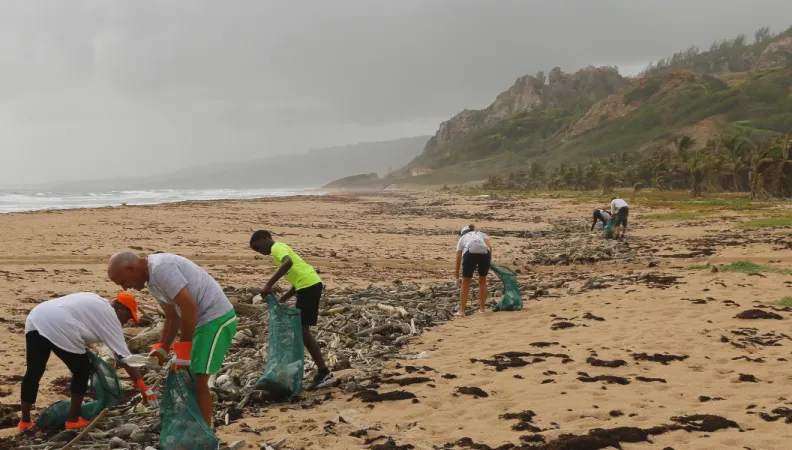Share the page
Conservation in the Caribbean: “It is essential to pull our resources together to multiply the impacts of our actions”
Published on

The upcoming conference on COP26 is focusing minds on the increasing urgency of climate change. Islands and coastal countries are among the most vulnerable. That’s why AFD and the French Facility for Global Environment (FFEM) have agreed to provide support to the Caribbean Biodiversity Fund (CBF) and its 12 affiliated National Trust Funds. We speak to Karen McDonald Gayle, Acting CEO of the Caribbean Biodiversity Fund, about how climate-related problems are being tackled in the region.
Some €4 million of support for the Caribbean Biodiversity Fund will contribute to the financing of the Caribbean Regional Architecture for Biodiversity (CRAB) program aimed at developing innovative, sustainable financing mechanisms to encourage the protection of biodiversity.
What are the most pressing biodiversity issues in the Caribbean?
Karen McDonald Gayle:
As ocean-based islands, the Caribbean is a hub for endemic species, full of biodiversity hotspots and corals. Marine life has been heavily impacted by climate change with the rise in sea levels, ocean warming and a proliferation of storm events being just some of the environmental challenges in the region.
The majority of our population lives on or near the coast and depends upon the goods and services provided by marine and coastal ecosystems. In the Caribbean, climate change affects the coastlines, and thus the populations. The consequences are dramatic: in some islands like Haiti, people have already been forced to relocate.
Hence the importance of protecting coastlines and the biodiversity on which coastal communities depend. How can the CRAB program, financed partly by AFD and FFEM, help meet these goals?
The Caribbean Regional Architecture for Biodiversity (CRAB) program has 3 objectives.
Building on what the Caribbean Biodiversity Fund (CBF) has already started, it aims to:
- to strengthen the financial and operational capacities of the Architecture by creating new opportunities of financing, especially for the conservation of biodiversity.
- to position the Architecture as a key player and facilitate regional approaches to biodiversity issues
- to reinforce its capacity to respond to local and regional conservation needs, including promoting the blue economy and strengthening the recovery capacity of countries in emergency responses
By consolidating the Architecture financially and technically, the program will support in the long term the maintenance and restoration of biodiversity and natural resources in the region. A key partner of the program is the OECS (Organization of Eastern Caribbean States), who will lead the CRAB component to develop Blue Bio Trade certified value chains to lessen the negative impacts of human and economic activity over marine ecosystems.
Find out more: A Regional Project Boosting Biodiversity in the Caribbean
How does regional cooperation reinforce national actions for effective and sustainable biodiversity conservation?
In the Caribbean context, economies of scale are key. We are neighbors, the idea of regional cooperation is to create more opportunities and learn from each other, by replicating a successful experience in a country in another one instead of starting from scratch each time, for example. These positive experiences also have a ripple effect on neighboring countries and trigger them to invest in their biodiversity conservation.
Volume counts: larger investments at once are more cost-effective for donors as it lessens the risks taken and the management resources needed to accompany the funding. The growing voice of the conservation trust funds supported by a regional structure is also more relevant nationally. It is thus essential to pull our resources together to multiply the impacts of our actions.
The national level conservation trust funds are independent and autonomous; they thus focus on their priority areas, build solid foundations, before working at the regional scale. Their regional work is focused on supporting the achievement of their national priorities.
Nature-based solutions are an important component of the CRAB project; can you explain how they are used on the ground to achieve the objectives of the project?
The CBF aims to reconcile biodiversity conservation and social development in the Caribbean. One is not opposed to the other, as the poorest populations need resilient ecosystems to feed themselves via fishing, hunting and gathering. The region’s high tourism base was heavily impacted by Covid-19.
The idea is to create income sources that are more resilient, with nature-based economic activities. And the results are already showing: the value of mangroves for climate resilience has been largely proven. At the same time, they also provide different income sources with mangrove honey for example, and thus opportunities to create new livelihoods. Thanks to CRAB, livelihoods will thus be strengthened at the same time as conservation mechanisms.
